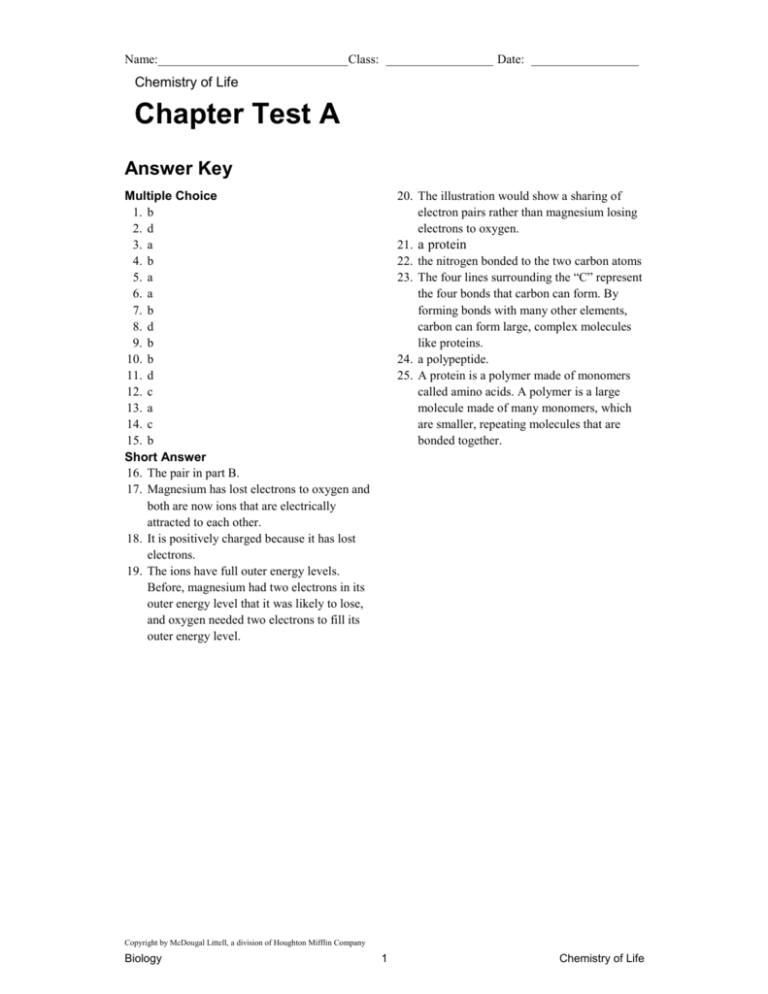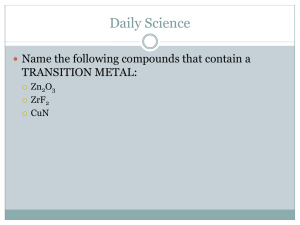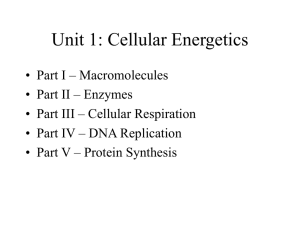Ch. 2 test
advertisement

Name:______________________________ Class: _________________ Date: _________________ Chemistry of Life Chapter Test A Answer Key Multiple Choice 1. b 2. d 3. a 4. b 5. a 6. a 7. b 8. d 9. b 10. b 11. d 12. c 13. a 14. c 15. b Short Answer 16. The pair in part B. 17. Magnesium has lost electrons to oxygen and both are now ions that are electrically attracted to each other. 18. It is positively charged because it has lost electrons. 19. The ions have full outer energy levels. Before, magnesium had two electrons in its outer energy level that it was likely to lose, and oxygen needed two electrons to fill its outer energy level. 20. The illustration would show a sharing of electron pairs rather than magnesium losing electrons to oxygen. 21. a protein 22. the nitrogen bonded to the two carbon atoms 23. The four lines surrounding the “C” represent the four bonds that carbon can form. By forming bonds with many other elements, carbon can form large, complex molecules like proteins. 24. a polypeptide. 25. A protein is a polymer made of monomers called amino acids. A polymer is a large molecule made of many monomers, which are smaller, repeating molecules that are bonded together. Copyright by McDougal Littell, a division of Houghton Mifflin Company Biology 1 Chemistry of Life Name:______________________________ Class: _________________ Date: _________________ Chemistry of Life Chapter Test A MULTIPLE CHOICE Choose the letter of the best answer. (15 credits) _____ 1. The smallest basic unit of matter is the a. molecule. b. atom. c. compound. d. cell. _____ 6. What is unique about carbon? a. bonding properties b. ability to bond with oxygen c. properties as a reactant d. properties as an enzyme _____ 2. Which of the following is formed when an atom gains or loses electrons? a. element b. compound c. molecule d. ion _____ 7. Which substance represented in Figure 2.1 (A or B) is the solvent? _____ 3. Atoms in molecules share pairs of electrons when they make a. covalent bonds. b. ionic bonds. c. hydrogen bonds. d. polymers. _____ 4. What gives water many properties that are important to living things? a. temperature b. hydrogen bonds c. density d. specific heat FIG. 2.1 a. b. c. d. both A and B substance A substance B neither A nor B _____ 5. Which of the following solutions has the highest H ion concentration? a. a solution with a pH of 1 b. a solution with a pH of 4 c. a solution with a pH of 7 d. a solution with a pH of 10 Copyright by McDougal Littell, a division of Houghton Mifflin Company Biology 2 Chemistry of Life Name:______________________________ Class: _________________ Date: _________________ Chapter Test A, continued _____ 8. The four main types of carbon-based molecules in organisms are carbohydrates, lipids, nucleic acids, and a. starches. b. fatty acids. c. monosaccharides. d. proteins. _____ 13. The activation energy needed for a chemical reaction is decreased by a a. catalyst. b. reactant. c. product. d. substrate. _____ 14. In the lock-and-key model of enzyme function shown in Figure 2.2, what is happening in step 2? _____ 9. Both animal fats and plant oils are made up of glycerol and a. phospholipids. b. fatty acids. c. polar molecules. d. saturated fats. _____ 10. Substances are changed into different substances when bonds break and form during a. chemical equilibrium. b. chemical reactions. c. ion formation. d. hydrogen bonding. FIG. 2.2 a. The catalyzed reaction is releasing a product. b. The active sites are restructuring the enzyme. c. The enzyme is causing new bonds to form between the substrates. d. The substrates are beginning to bind to the enzyme. _____ 11. Identify the products in this reaction: 6H2O 6CO2 C6H12O6+ 6O2. a. 6H2O and 6CO2 b. 6CO2 and C6H12O6 c. 6H2O, C6H12O6, and 6O2 d. C6H12O6 and 6O2 _____ 15. Which aspect of a chemical reaction is affected by enzymes? a. direction b. rate c. equilibrium d. pH _____ 12. Chemical reactions that absorb more energy than they release are called a. exothermic. b. catalyzed. c. endothermic. d. activated. Copyright by McDougal Littell, a division of Houghton Mifflin Company Biology 3 Chemistry of Life Name:______________________________ Class: _________________ Date: _________________ Chapter Test A, continued Short Answer Use the diagram below to answer items 16–20. (5 credits) FIG. 2.3 16. Which pair of atoms are ions? _______________________________________________________________ 17. How can you tell that an ionic bond is formed between magnesium and oxygen? _______________________________________________________________ _______________________________________________________________ 18. Remembering that electrons are negatively charged, is magnesium in part B positively or negatively charged? Why? _______________________________________________________________ 19. Why is the compound magnesium oxide more stable than its separate components, magnesium and oxygen? _______________________________________________________________ _______________________________________________________________ _______________________________________________________________ 20. How would the illustration be different if magnesium and oxygen formed covalent bonds? _______________________________________________________________ _______________________________________________________________ Copyright by McDougal Littell, a division of Houghton Mifflin Company Biology 4 Chemistry of Life Name:______________________________ Class: _________________ Date: _________________ Chapter Test A, continued Use the diagram below to answer items 21–25. (5 credits) FIG. 2.4 21. Figure 2.4 shows the basic molecular structure of amino acids and how they bind together. What type of molecule is formed by amino acids? _______________________________________________________________ 22. What part of the amino acid in the center of the diagram is the amino group? _______________________________________________________________ 23. At the center of the diagram is a carbon molecule. What do the four lines that surround the “C” illustrate about carbon? _______________________________________________________________ 24. The arrows point to peptide bonds between amino acids. What is the name of a chain of amino acids linked by peptide bonds? _______________________________________________________________ 25. Is a protein a monomer or a polymer? Define these terms in your answer. _______________________________________________________________ Copyright by McDougal Littell, a division of Houghton Mifflin Company Biology 5 Chemistry of Life








